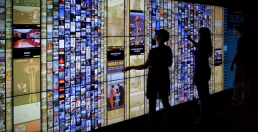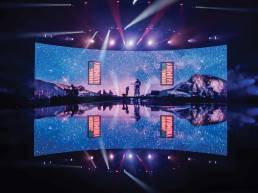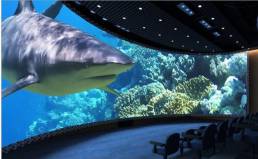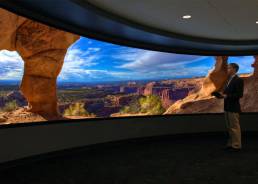What kind of video wall is suitable for you?
LCD? Projection cubes? Direct view LED? Which one do you think is better for you? Which one is worth to invest on? Well the answer to this question is not surely the same for everyone of business. Every display technologies has unique strengths and weaknesses. To help you better, we’ve prepared a nice guide to let you have better choice.
✓ LCD Video Wall
Literally LCD is an abbreviation of “Liquid Crystal Display”, and LED stands for “Light Emitting Diodes”. You should be probably familiar with LCD technology due to its common use in consumer electronics such as smartphones, monitors and etc.
An LCD is a flat panel display composed of a layer of liquid crystal between two pieces of polarized glass. When an electric current is applied, the liquid crystals shift, allowing light to pass through to create an image. Liquid crystals don’t produce their own light, so backlights are arranged behind the glass to illuminate the display. LEDs (light-emitting diodes) are the most common type of backlight used in modern LCD displays.
Generally LCD video walls is a large visualization surface that is made by various LCD displays called ‘tiles’. In fact video walls come in various forms to supply your needs like wall mounting, flexible and portable.
Applications of LCD Video Walls
- Control room operations
- Shopping malls and stores
- Education centers
- Conference rooms


✓ LED Video Wall
LED Display is a newer technology than LCD display. LED surely provides sharper and higher quality visual content. Direct view LED isn’t actually a new technology: it’s been used for decades in large, outdoor signage, but has traditionally lacked the resolution needed for close-proximity indoor displays. Todays there is higher demand for LEDs comparing to LCD displays.
An LED display consists of hundreds of tiny LEDs (light emitting diodes) mounted directly on a flat panel. Each LED is essentially a miniature lightbulb that emits colored light when a particular voltage is applied to it. Clusters of red, green, and blue LEDs are grouped to create the full-color pixels needed to produce an image. Since the LEDs themselves produce the pixels, the size of the LEDs and the distance between them (known as “pixel pitch”) determines the resolution of the display. Displays with very small LEDs and a fine pixel pitch will produce higher resolutions than displays with bigger LEDs and a large pixel pitch. However, these higher-resolution displays are also dramatically more expensive.
Generally LED video walls is a large visualization surface that is made by various LCD displays called ‘tiles’. This type of video wall is designed to totally minimize and remove bezel width. LED video walls also come in various forms such as wall mounting, flexible and ceiling mounting and etc.
Applications of LCD Video Walls
- Operation room
- Shopping malls and stores
- Conference rooms
✓ Blended Projection Systems
Blended Projection Systems combine the output of multiple projectors to produce an image that is larger or higher-resolution than could be generated by a single projector. Blended projection systems can display high-resolution images on a completely seamless surface of virtually any size and shape.
Blended projection works by overlapping two or more projected images and gradually cross-fading their edges to produce a single, seamless image. A blended projection system can be designed with rear or front projection. In a rear blended projection system, the projectors are placed behind the screen in an enclosed room, where they either project light directly onto the screen, or onto mirrors that then reflect it onto the screen. In a front blended projection system, the projectors are mounted in front of the screen surface and reflect light directly onto it.
Applications of Blended Projection Systems
- Simulation
- Architecture and engineering
- Education and research


✓ Rear Projection Video Walls
Like LCDs, rear projection display is (sometimes called “cubes”) a popular display option. This display type has existed for many years and is available in a range of sizes and resolutions.
A rear projection display consists of a projection system and mirror encased in a sealed cube. The cube enclosure is used to limit the effects of ambient light and improve the brightness and contrast levels of the displays. Inside the cube, the projector shines light onto a mirror, which then reflects it onto the display screen to produce an image.
Applications of LCD Video Walls
- Operation room
- Shopping malls and stores
- Conference rooms

